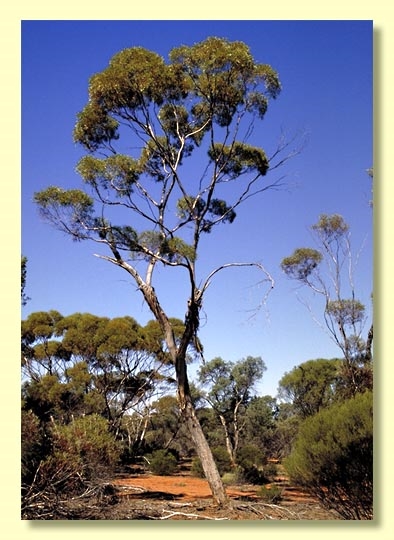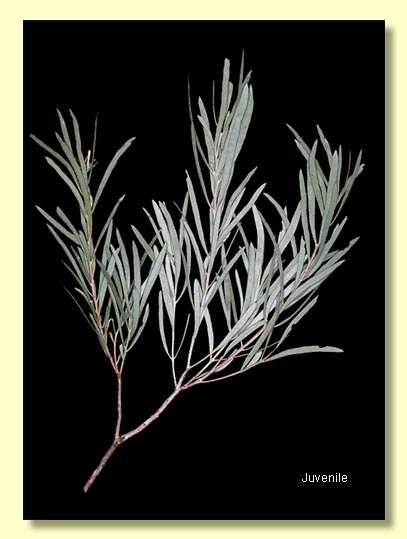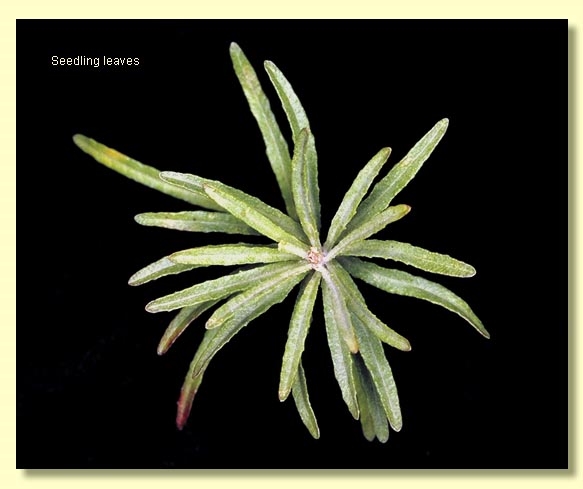Euclid - Online edition
Eucalyptus formanii
Eucalyptus | Symphyomyrtus | Bisectae | Destitutae | Porantherae | Longiores
T: Die Hardy Ra., near Mt Jackson, W.A., July 1940, F.G.Forman & R.S.Matheson s.n.; holo: PERTH.
Bark rough over part or all of trunk extending to base of large limbs, fibrous to scaly or wavy-flaky, grey-brown, shedding on branches in scruffy ribbons to show smooth cream brown to pinkish grey.
Branchlets lacking oil glands in the pith.
Juvenile growth (coppice or field seedlings to 50 cm): stems rounded in cross-section, warty or smooth, glaucous or not; juvenile leaves sessile or very shortly petiolate, alternate, linear, 2–4.5 cm long, 0.2–0.4 cm wide, grey-green to slightly glaucous, new growth usually glaucous.
Adult leaves alternate, held erect, petioles 0–1 cm long; blade linear, 3.5–9.5 cm long, 0.2–0.5 cm wide, base tapering, margin entire, apex finely pointed, concolorous, new growth grey-green maturing glossy, green, side-veins greater than 45° to midrib or obscure, reticulation moderate to dense, intramarginal vein obscure or present, oil glands mostly intersectional.
Inflorescence axillary unbranched, peduncles rounded, 0.4–1 cm long, buds 7 or 9 per umbel, pedicels 0.2–0.3 cm long. Mature buds ovoid to fusiform (0.4–0.7 cm long, 0.25–0.3 cm wide), scar present, operculum conical to beaked (0.3–0.4 cm long), stamens inflexed, anthers cuneate-cuboid, adnate to filament apex (rigidly basifixed), dehiscing by sub-terminal pores, a few of the innermost stamens imperfectly formed, style long and straight, stigma tapered, locules 3 or 4, the placentae each with 4 vertical rows of ovules. Flowers creamy white.
Fruit pedicellate (pedicels 0.2–0.3 cm long), cupular to hemispherical, 0.3–0.4 cm long, 0.4–0.5 cm wide, disc level to descending, valves 3 or 4, more or less exserted.
Seeds brown, 1–2 mm long, flattened-ovoid, dorsal surface furrowed longitudinally, scarcely reticulate, hilum ventral.
Cultivated seedlings (measured at node 10): cotyledons Y-shaped (bisected); stems rounded in cross-section, very warty, usually glaucous; leaves sessile, opposite for ca 4 nodes then spirally arranged for many "nodes", linear, 2–4.5 cm long, 0.1–0.5 cm wide, margin irregular due to warts, discolorous, grey-green above, glaucous below. Leaves densely arranged on stem.
Flowering time unknown.
A small tree or rarely a mallee endemic to Western Australia, found only in the arid Die Hardy Range area north of Bullfinch. The bark is rough over part or all of the trunk or stems and smooth, finally coppery, above. The adult leaves are erect, linear, slightly glossy, green.
Eucalyptus formanii belongs in Eucalyptus subgenus Symphyomyrtus section Bisectae subsection Destitutae because the buds have two opercula, cotyledons are Y-shaped and branchlets lack oil glands in the pith. Within this subsection E. formanii is one of a group of about 16 species, series Porantherae, that are further characterised by having anthers completely adnate to the staminal filaments, strongly inflexed stamens, densely reticulate leaves with intersectional oil glands and by the fruit with a distinct thick rim that includes a whitish descending disc. The small, glossy leaves of species in series Porantherae may result in confusion with species in series Heterostemones; however, the fruit alone usually distinguish the series. The fruit of series Heterostemones are thin-rimmed.
The juvenile leaves are the most distinctive of any species in series Porantherae, being crowded, linear, grey-green to glaucous, glandular on the margin and very conspicuous as regrowth from a lignotuber or as stem coppice. There should be no confusing this species with any other in its natural range.
The crowded, fine-leaved coppice may have ornamental value.















